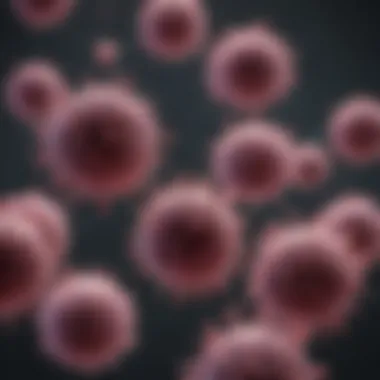Understanding the Role of White Blood Cells in Immunity


Intro
The immune system serves as the body's defense mechanism, protecting against pathogens and diseases. Among its various components, white blood cells, also known as leukocytes, play an essential role. These cells are not a uniform group; instead, they consist of diverse types that contribute differently to immunity. Understanding these differences is crucial for grasping how our body maintains health and combats infections.
Key Concepts
Definition of Primary Terms
White blood cells can be identified primarily as immune cells, which can be broadly categorized into two types: innate immune cells and adaptive immune cells.
- Innate immune cells provide immediate defense; they act quickly and are non-specific. These include neutrophils, eosinophils, and macrophages.
- Adaptive immune cells, such as B cells and T cells, offer a more tailored response to specific pathogens. Their actions not only target infections but also create a memory, allowing for faster responses in future encounters with the same pathogen.
Related Concepts and Theories
Understanding these cells requires familiarization with concepts like cytokines, which are signaling molecules that help mediate and regulate immunity. The interaction among different types of white blood cells and their ability to communicate is significant in the immune response. Furthermore, theories surrounding autoimmunity and immunodeficiency illustrate situations where the immune system fails, leading to health issues.
A relevant model in immunology is the danger theory, which posits that the immune system responds not just to pathogens but also to bodily damage and stress signals. This perspective shifts focus to the context in which the immune response operates, illustrating its complexity.
"White blood cells are the foot soldiers of our immune system, patrolling the body for intruders and facilitating defense mechanisms."
Immune Cells In Detail
Neutrophils
Neutrophils are the most abundant type of white blood cells and serve as the first line of defense during infections. They are known for their rapid response and ability to engulf and destroy pathogens through a process called phagocytosis. Their lifespan is short, leading them to be constantly replenished in the bloodstream.
Lymphocytes
Lymphocytes comprise two types: B cells and T cells. B cells are primarily responsible for antibody production, whereas T cells can kill infected host cells or help activate other immune cells. This division of labor is crucial for a robust adaptive immune response.
Monocytes
Monocytes develop into macrophages or dendritic cells upon migrating into tissues, where they also play significant roles in phagocytosis and activating T cells. Their ability to present antigens is central to linking the innate and adaptive immune systems.
Future Directions
Gaps Identified in Current Research
Despite the extensive knowledge available, gaps still exist. One such gap is understanding how individual differences in immune response can affect disease susceptibility and responses to vaccines. More longitudinal studies are required to observe these variations effectively.
Suggestions for Further Studies
Future research should focus on the interaction between gut microbiota and immune cell function, as emerging evidence suggests these relationships significantly impact overall health. Additionally, exploring targeted therapies that enhance the efficacy of white blood cells in treating certain conditions could revolutionize current medical practices.
Prelude to White Blood Cells
Understanding the role of white blood cells is essential for grasping how the immune system protects the body. These cells are not just components of the blood; they are key players in defense mechanisms that ensure survival against various pathogens. The immune response relies on these cells to identify, attack, and eliminate threats such as viruses and bacteria.
In this article, we will examine the characteristics, types, and functions of white blood cells. Such detailed exploration provides insight into their mechanisms, which can aid in understanding disease prevention, treatment, and health overall. The significance of this topic extends to students and professionals alike, who can benefit from comprehending the inner workings of the immune system and its cellular defenders.
Definition and Function
White blood cells, or leukocytes, are specialized cells in the bloodstream that primarily function in immune defense. They are produced in the bone marrow and play a crucial role in the body's ability to ward off infections. Each white blood cell type has distinct responsibilities.
The primary functions of these cells include:
- Identifying pathogens: White blood cells recognize foreign invaders.
- Attacking pathogens: They can destroy bacteria and viruses directly or through signaling other immune components.
- Facilitating healing: After an immune response, they help in tissue repair.
The overall operation of white blood cells is pivotal for maintaining homeostasis and health.
Types of White Blood Cells
There are several types of white blood cells, each categorized broadly into two groups: granulocytes and agranulocytes. Understanding these types is vital for comprehending how the immune system functions in both immediate and long-term responses.
Granulocytes include neutrophils, eosinophils, and basophils. They are characterized by the presence of granules in their cytoplasm and play immediate roles in immune response.
Agranulocytes consist of lymphocytes and monocytes. Lymphocytes are essential for adaptive immunity, while monocytes are involved in phagocytosis, a process critical for destroying pathogens and alerting other immune cells to the presence of infection.
The diversity of white blood cells ensures that the body can respond effectively to a wide range of threats. Each type, with its unique properties, contributes to a robust immune defense, thereby highlighting the importance of studying these crucial cells.
The Role of White Blood Cells in Immunity
White blood cells, or leukocytes, are integral components of the immune system. Their primary role is to defend the body against infectious disease and foreign invaders. Understanding the role of these cells in immunity is essential for grasping how the immune system functions overall. The various types of white blood cells each have specialized functions, allowing for a coordinated and effective response.
When an infection occurs, white blood cells spring into action, identifying and neutralizing pathogens. Key elements of this response include their ability to communicate with each other and target specific threats. This cooperation among cells ensures that the immune system can manage not only bacterial and viral infections, but also more intricate challenges like cancer.


The benefits of understanding these roles extend to fields such as medicine and immunology. Knowledge about white blood cells aids in developing therapies for autoimmune diseases and vaccines. The dynamic nature of immune responses highlights the critical need for research that furthers our understanding of how these cells operate within the immune system.
Overview of Immune Response
The immune response is a complex and coordinated system involving various types of white blood cells that react to pathogens. It can be divided into two main components: innate immunity and adaptive immunity.
- Innate Immunity: This is the body's first line of defense. It consists of physical barriers like skin and mucous membranes, as well as immune cells that respond swiftly to infection. Neutrophils and macrophages are key players in this aspect.
- Adaptive Immunity: This component develops more slowly and involves a specific response to pathogens through lymphocytes, particularly T cells and B cells. The adaptive immune response has a memory capability that allows for quicker reactions in subsequent exposures to the same pathogen.
The immune response ensures that the body is continually protected. Once a threat is identified, white blood cells begin signaling each other to mount a defense, creating a strengthened response that can adapt to invaders over time.
Innate Immunity vs. Adaptive Immunity
Innate and adaptive immunity work in conjunction but have distinct characteristics.
- Innate Immunity
- Adaptive Immunity
- Speed: Immediate response.
- Specificity: Non-specific; recognizes general patterns on pathogens.
- Components: Physical barriers, various white blood cells like neutrophils, macrophages, natural killer cells.
- Speed: Slower to develop initially, but faster upon later exposure due to memory cells.
- Specificity: Highly specific to individual pathogens, with tailored responses.
- Components: Primarily lymphocytes like T cells and B cells, which produce antibodies against specific foes.
Both types of immunity are vital. While innate immunity acts fast to provide immediate defense, adaptive immunity tailors long-term protection and enhances future responses. The interaction between these two systems exemplifies the sophistication of the immune response and emphasizes the complex role white blood cells play in maintaining health.
"The immune system cannot work in isolation, its various components must communicate effectively to ensure a precise response to pathogens."
Understanding these mechanisms empowers researchers and healthcare providers to develop better diagnostic tools and treatments. This knowledge is crucial for innovations in vaccines and therapies, thereby directly impacting public health.
Granulocytes
Granulocytes play a crucial role in the immune response of the human body. These cells are a subset of white blood cells characterized by the presence of granules in their cytoplasm. There are three main types of granulocytes: neutrophils, eosinophils, and basophils. Each type performs specific functions that contribute to the overall effectiveness of the immune system. Understanding granulocytes is essential, as they are often the first responders to infection and inflammation.
Neutrophils
Characteristics
Neutrophils are the most abundant type of white blood cells, making up about 55-70% of all granulocytes. Their primary characteristic is their multilobed nucleus and the presence of granules containing enzymes. These enzymes play a vital role in the military against pathogens. Their swift movement to infection sites makes them a potent force in the immune response. The ability of neutrophils to engulf and destroy bacteria marks their importance in this article. However, their short lifespan, typically lasting only a few hours to days, can limit their long-term effectiveness in fighting infections.
Mechanism of Action
The mechanism of action of neutrophils involves several steps. Upon detecting a pathogen, they undergo a process called chemotaxis, moving toward the infection site. Once they arrive, they engulf pathogens via phagocytosis. Neutrophils also release antimicrobial substances and reactive oxygen species to eliminate invaders. This mechanism is beneficial to rapidly control infections. Nonetheless, excessive neutrophil activation can lead to tissue damage, displaying a disadvantage in chronic inflammation.
Role in Infection Response
In the context of infection response, neutrophils serve as the frontline defense. They respond swiftly to invading bacteria and fungi, encapsulating them for destruction. Their ability to communicate with other immune cells enhances the entire process of inflammation. This collaborative role is beneficial to the immune system. However, overactivity can contribute to conditions like sepsis, which poses a serious risk to human health.
Eosinophils
Characteristics
Eosinophils represent a smaller percentage of white blood cells, usually around 1-4%. Their characteristic feature is the bright orange coloration of their granules when stained. This property helps in identifying them under the microscope. Eosinophils are larger than neutrophils and are particularly useful in combating larger parasites. Additionally, they are involved in allergic responses. Their presence is significant, but their elevated levels can indicate various disorders, making their role complex.
Functions in Allergic Reactions
Eosinophils have a key role in allergic reactions, particularly in the response to allergens. When allergens are detected, these cells release granules that contain inflammatory mediators, such as histamine. This release helps to amplify the allergic response. Importantly, this function is beneficial for clearing parasitic infections but may lead to tissue inflammation in allergies, showing how their role can be both protective and detrimental.
Response to Parasitic Infections
Eosinophils are essential in responding to parasitic infections like helminths. They attach to these larger parasites and release toxic granules that lead to their destruction. This unique capability highlights eosinophils' importance. However, the challenge lies in the fact that their specific functioning often requires a regulated environment; an excessive response can cause tissue damage and inflammation in the host.
Basophils
Characteristics
Basophils are the least common type of granulocytes, constituting less than 1% of white blood cells. Their defining characteristic is large granules that stain dark blue or purple. They contain histamine and heparin, substances involved in inflammatory responses. Although they are rare, basophils are critical in mediating allergic reactions and inflammation. Their small numbers often pose a challenge when studying their specific roles in the immune system.
Role in Allergic Responses
Basophils contribute significantly to allergic responses, particularly in conditions like asthma and hay fever. Upon encountering an allergen, they release histamine and other mediators, promoting inflammation and increasing blood flow to the affected areas. This action is vital for recruiting other immune cells. Nonetheless, their overactivity can exacerbate allergic conditions, leading to severe reactions such as anaphylaxis, underlining their dual role in providing protection and causing adverse effects.
Importance in Inflammation
In terms of inflammation, basophils are crucial for initiating and sustaining the inflammatory response. They release various substances that attract other immune cells to the site of infection or injury. This recruitment is beneficial for amplifying the immune response. However, their involvement in chronic inflammation can lead to harmful long-term effects, such as tissue damage and chronic inflammatory diseases.
Understanding granulocytes is essential for appreciating their multifaceted roles in the immune system. Each type has a distinct purpose, impacting health in various ways.
Agranulocytes


Agranulocytes are a crucial component of the immune system. Unlike granulocytes, which contain granules in their cytoplasm, agranulocytes lack these granules. This section highlights their importance and mechanisms within the immune response. Agranulocytes include lymphocytes and monocytes, both of which play significant roles in adaptive immunity.
Lymphocytes
Lymphocytes are predominantly recognized for their pivotal role in the immune system, especially within the context of adaptive immunity. They can be broadly categorized into two main types: T cells and B cells. Each type serves a unique function that complements the overall immune response.
Types of Lymphocytes
The two primary types of lymphocytes are T cells and B cells. T cells are essential for cell-mediated immunity, while B cells are important for humoral immunity. The distinction between these cells is vital for understanding their roles in fighting infections and diseases.
Key characteristics of lymphocytes include:
- Specificity: Lymphocytes can recognize specific antigens due to their unique receptors.
- Memory: After exposure to an antigen, some lymphocytes develop into memory cells, enhancing the response to future infections by the same pathogen.
The unique feature of lymphocytes is their ability to adapt to various pathogens over time. This adaptability strengthens the immune response against repeated infections, making lymphocytes a beneficial aspect of the immune system.
T Cells: Function and Types
T cells are integral for numerous immune functions. They include Helper T cells, which aid other immune cells, and Cytotoxic T cells, which destroy infected cells. Their ability to target infected or abnormal cells is crucial for controlling infections.
Key characteristic of T cells:
- Activation: T cells require specific antigen recognition to become activated, which is essential for their role in the immune response.
One unique feature of T cells is their capacity for ‘memory’ storage. It allows them to respond swiftly to previously encountered pathogens, proving advantageous in prolonged immune surveillance.
B Cells: Function and Antibody Production
B cells are central to the immune response as they produce antibodies. These proteins bind to specific antigens, marking them for destruction or neutralization. Their role is crucial in preventing infectious disease, especially in combating extracellular pathogens.
Key characteristic of B cells:
- Antibody Diversity: B cells can produce a large variety of antibodies tailored to specific pathogens.
The unique feature of B cells is the capacity to undergo affinity maturation—a process where their antibodies increase in effectiveness through repeated exposure to an antigen. This adaptability is a significant advantage in creating a robust and long-lasting immunity.
Monocytes
Monocytes are large white blood cells that originate from the bone marrow. They circulate in the blood and migrate into tissues as needed. Monocytes play essential roles in both innate and adaptive immunity.
Characteristics
Monocytes have distinctive characteristics that set them apart from other white blood cells.
Key characteristic of monocytes:
- Size and Shape: They are larger compared to lymphocytes, with a kidney-shaped nucleus.
This size gives monocytes a stronger capacity for phagocytosis—the process of engulfing and digesting pathogens, contributing greatly to the body's defense.
Transformation into Macrophages
Upon entering tissues, monocytes differentiate into macrophages. This transformation enhances their ability to eliminate pathogens and debris. Macrophages are known for their role in wound healing, as well as in presenting antigens to lymphocytes, linking the innate and adaptive immune responses.
The transformation is beneficial as macrophages are more effective in their roles compared to their monocyte precursors.
Role in Phagocytosis
Phagocytosis is a critical function of monocytes and macrophages. It involves the ingestion of pathogens, leading to their destruction within the cell. This process not only eliminates threats but also initiates an inflammatory response, recruiting additional immune cells to the site of infection.
Key characteristics of this role include:
- Pathogen Clearance: Phagocytosis helps to clear infections efficiently.
This unique feature of monocytes as phagocytes is essential for maintaining immune homeostasis and defending against various infections.
Role of White Blood Cells in Disease Prevention
The significance of white blood cells extends deeply into the realm of disease prevention. These cells are vital components of the body's immune system, tasked primarily with identifying and eliminating foreign invaders such as pathogens and malignant cells. Their proactive engagement in disease defense shapes the overall health landscape. In this section, we will explore two critical aspects of white blood cell functionality: targeting pathogens and surveillance against cancer.
Targeting Pathogens
When pathogens enter the body, whether it be bacteria, viruses, or fungi, white blood cells spring into action. They function as sentinels, ready to identify and neutralize these threats. Different types of white blood cells organize a coordinated attack against invading pathogens.
- Neutrophils are often the first responders. They migrate rapidly to the site of infection. Their primary function is phagocytosis, which means they engulf and digest pathogens.
- Macrophages also play a significant role. They consume pathogens and help to initiate an immune response by presenting antigens to lymphocytes.
- Lymphocytes, particularly T cells and B cells, are tailored to recognize specific pathogens. T cells can directly kill infected cells, while B cells are responsible for producing antibodies that bind to invaders, marking them for destruction.


Through these mechanisms, white blood cells dramatically lower the chance of an initial infection progressing into a more severe illness. Their ability to adapt and respond to various pathogens underlines their importance in disease prevention.
Surveillance Against Cancer
In addition to targeting pathogens, another critical role of white blood cells is cancer surveillance. Cancer cells can arise in the body through mutations, leading to uncontrolled growth. White blood cells are among the primary defenders against such aberrations.
- Natural Killer (NK) cells are specialized lymphocytes that can recognize and destroy some cancerous cells without prior sensitization. They monitor for abnormal cell behavior and act rapidly when abnormalities are detected.
- T cells, especially cytotoxic T cells, are critical in identifying and destroying infected or malignant cells. They are trained to recognize specific tumor markers on cancer cells, leading to a targeted immune response.
- Monocytes, when transformed into macrophages, also contribute by engulfing cancer cells and stimulating other immune cells to react.
According to various studies, the efficacy of cancer treatment can often be enhanced by leveraging the immune response, indicating that white blood cells play a pivotal role in controlling tumor growth and progression.
Understanding how white blood cells operate against both pathogens and cancer forms the foundation for developing treatments and vaccines. Their importance in preventing diseases cannot be overstated, as their timely and efficient response determines the body’s overall defense efficacy. In the following sections, we will further delve into the clinical implications of these cells and explore the factors that may influence their functionality.
Factors Affecting White Blood Cell Function
Understanding the factors affecting white blood cell function is crucial in immunology. These cells are the backbone of the immune system, playing a vital role in defending against pathogens and maintaining overall health. Factors such as genetic predispositions, environmental elements, and lifestyle choices can influence their effectiveness and functionality. This section discusses how these variables shape the immune response at a cellular level.
Genetic Factors
Genetic factors significantly impact the development and function of white blood cells. Certain genetic markers may predispose individuals to different immune responses or vulnerabilities to diseases. For example, mutations in genes related to immune function can result in disorders like Severe Combined Immunodeficiency (SCID) or Autoimmune Diseases. This highlights that
"The immune response is not only influenced by external factors but also programed within our DNA."
Key Aspects of Genetic Factors:
- Inherited Traits: Family history can dictate susceptibility to specific infections or autoimmune conditions.
- Gene Mutations: Changes in genes involved in white blood cell signaling can alter immune efficacy.
- Epigenetics: Environmental triggers, such as diet or stress, can affect gene expression without altering DNA sequence.
These aspects underline the importance of genetics in shaping the immune system's resilience and adaptability to changing environments.
Environmental Influences
Environmental factors play an essential role in modulating white blood cell function. Exposure to various stimuli can either enhance or inhibit the immune response.
Some environmental influences include:
- Pollution: Studies indicate that prolonged exposure to pollutants can weaken immune response, reducing the efficacy of white blood cells.
- Infections: Prior infections can train the immune system, often resulting in a more robust response to future infections.
- Nutrition: A balanced diet rich in vitamins and minerals supports healthy immune function.
- Stress: Chronic stress is known to have detrimental effects on white blood cells, often leading to reduced immune responses.
These elements demonstrate that the environment interacts intricately with genetic predispositions. Understanding these influences is critical for developing effective medical interventions that support immune health.
Evaluating both genetic and environmental factors is essential for researchers and healthcare providers alike in understanding and improving individual immune responses.
Clinical Importance of White Blood Cells
White blood cells play an essential role in the clinical landscape of medicine. Their significance extends from basic diagnostics to advanced therapeutic interventions. Understanding these vital cells is crucial not only for students and professionals in healthcare but also for anyone interested in the immune system's workings.
Diagnostic Use in Medicine
The use of white blood cells in diagnostics provides valuable insights into an individual’s health status. When a physician suspects an infection, inflammation, or other conditions, a complete blood count (CBC) is often performed. This test helps to assess the quantity and types of white blood cells present. An elevated white blood cell count can indicate infection, whereas a low count may suggest bone marrow issues or autoimmune disorders.
- Leukocyte Count: The total number of white blood cells can guide the understanding of a patient's immune status.
- Differential Count: This gives breakdowns of different white blood cell types such as neutrophils and lymphocytes, assisting in pinpointing specific conditions.
In addition, certain white blood cells can serve as biomarkers for specific diseases. For example, increased eosinophils could indicate an allergic reaction or parasitic infection. Thus, understanding the dynamics of white blood cells is crucial in disease diagnosis and monitoring.
"The white blood cell count is a fundamental diagnostic tool, reflecting the body’s response to various health issues."
Therapeutic Applications
The therapeutic potential of white blood cells is vast and increasingly recognized in modern medicine. Immunotherapy is one field where white blood cells have gained prominence, especially in cancer treatment. This approach harnesses the body’s immune system to fight tumors.
- CAR T-Cell Therapy: This groundbreaking treatment modifies T cells to target specific cancer cells, showing remarkable results in some leukemia and lymphoma patients.
- Monoclonal Antibodies: These are laboratory-made molecules that can mimic the immune system’s ability to fight off harmful pathogens. They are used in treating various conditions, including cancers and autoimmune diseases.
Moreover, understanding white blood cell behavior has opened paths to develop vaccines and other immunotherapies. By training the immune system to recognize and attack specific pathogens or cancer cells, healthcare can enhance treatment efficacy and patient outcomes.
Overall, the clinical importance of white blood cells encompasses both diagnostics and therapeutic avenues. As research advances, the understanding of these cells continues to evolve, highlighting their pivotal role in healthcare.
End
The concluding section of this article is vital to encapsulating the essential role white blood cells play in the immune response. Through detailed examination, it is clear that these cells are not merely components of blood; they are the frontline defenders against pathogens and are integral to overall health. Each type of white blood cell, from granulocytes to agranulocytes, contributes uniquely to our immune system's functionality. Their interrelationships and individual actions form a comprehensive defense network that is constantly adapting to threats.
Summary of Key Points
In summary, the roles of white blood cells can be outlined as follows:
- Diverse Purposes: Different types of white blood cells serve varied purposes, including immediate infection response and long-term immunity development.
- Mechanisms of Action: Various mechanisms are utilized by these cells, such as phagocytosis by macrophages and antibody production by B cells.
- Pathogen Defense: White blood cells target and neutralize pathogens like bacteria and viruses, involving cooperation among different cell types.
- Monitoring Cancer: They also participate in surveillance against abnormal cells, playing a role in cancer prevention.
The clinical significance of studying these cells lies in their diagnostic and therapeutic roles. Advanced understanding can lead to better disease management and therapeutic interventions.
Future Directions in Immunology Research
Looking to the future, immunology research will likely delve deeper into several key areas. The exploration of white blood cells will enhance the understanding of not just infections but also autoimmune diseases and cancers. Future studies might focus on:
- Personalized Immunotherapy: Tailoring treatments based on individual immune responses may lead to better outcomes in diseases like cancer and chronic infections.
- Understanding Aging: Research on how white blood cell function changes with age could provide insights into elder care and age-related diseases.
- Impact of Microbiome: Investigating the relationship between gut microbiota and white blood cell activity may unravel novel pathways in disease prevention and health optimization.
In summary, the narrative around white blood cells is likely to expand. Their importance in health and disease is unlikely to diminish. Continuous research will be crucial in leveraging this knowledge for better health outcomes.



